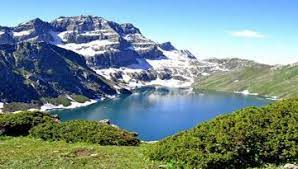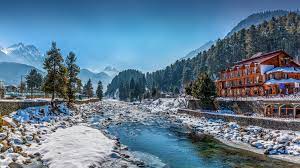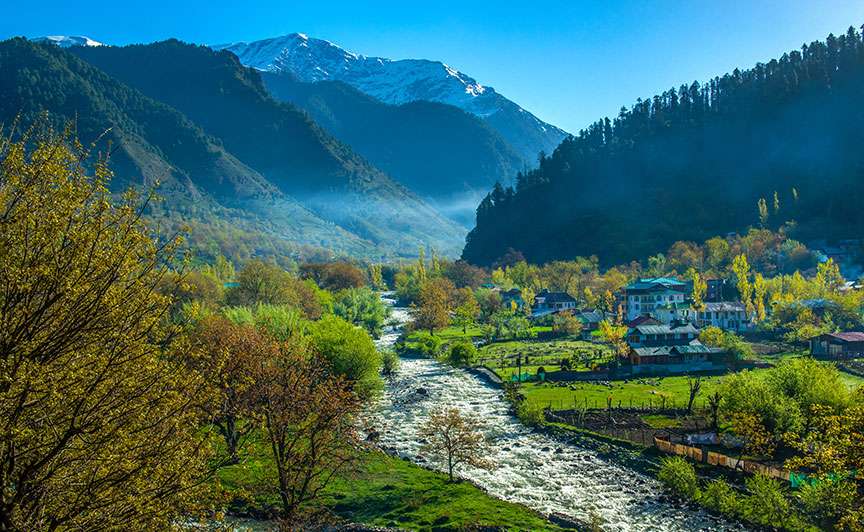Anantnag
Anantnag is a stupendous and wonderful location of world tourism. It is the key place from where many tourist spots can be explored in Kashmir Valley. Anantnag is a perfect place for people looking for picturesque scenery along with pleasant climate in India. It is a distinguished place of valley and displays the vivid colours of Jammu and Kashmir tourism. Basically, the state of Jammu and Kashmir is divided into three major areas according to tourism. These are Jammu region, Kashmir valley region, and Leh region. Among these Kashmir Valley is one of the magnificent places which display the mesmerising sightseeing of nature. Anantnag is an undisputed part of this region which carries all the beauty and natural gorgeousness of earth.
Anantnag boasts of many beautiful attractions which draws people from around the world. Tourists who come to Anantnag to persuade their enthusiastic senses get full satisfaction of tourism by the expedition of this place. Due to its immaculate splendour, Kashmir valley is also called as heaven on earth. People who have visited abroad locations such as Switzerland find Anantnag as a replica of that pristine destination. Along with natural beauty and scenery, Anantnag also showcases the historical places and religious places which have much importance in world history. Some of the renowned wildlife sanctuaries are also established which makes it perfect for discovering flora and fauna of Anantnag. Here are some details of Anantnag tourism along with some factors which are essential while arriving at Kashmir.
Parks and Gardens in Anantnag
Anantnag can be termed as the garden city of Kashmir. There are many Gardens and Parks in and around Anantnag. Since ancient times this place was among the favourite tourist destinations of royal families. Among them, Mughals had the most significant impact on the tourism of Anantnag. They were very fond of natural beauty and Kashmir was the best of all. Hence they had incepted various gardens and parks in Anantnag region to make this place more adoring and magnificent. Some popular parks and gardens are:
- Achabal Garden
- Padshahi Bagh Bijbehara
- Mughal Garden Verinag
- Botanical Garden Kokernag
- Aishmuqam Park
- Akad Park
- Poshwan Park
- Lidder View Park
- Sher Bagh park
- Mattan park
Natural Springs in Anantnag
Anantnag has derived its name from the numerous springs inundating the whole region. The name Anantnag means, Anant- numerous, Nag- Springs. The city has many beautiful natural springs which enhance its natural beauty. Some of these springs are contained in stone basins built during the ancient Mughal times. The gardens of Achabal and Verinag are fine examples of Mughal architecture and penchant for natural beauty. These Mughal gardens have famous Persian style and thoughtful carvings on stone. They served as the Pleasure retreat for the royals. Kokernag is another natural spring in Anantnag. It is, in fact, a collection of small channels originating from the foothills of a mountain in dense forests and they form the shape of hen’s claw called Koker locally.
History and Heritage
Anantnag is one of the world's oldest human settlements, having been continuously inhabited for almost 3000 years. Anantnag has been mentioned in legendary epics, ancient chronicles, and archival records as a natural-born historical city-state from the Neolithic age. The district's name, like everything else about it, symbolises its fascinating history.
The name Anantnag is a combination of the Sanskrit word 'Ananta,' which means countless, and the Kashmiri word 'naga,' which means water springs; thus, Anant-nga means 'land of countless springs.' According to archaeologist Sir Aurel Stein, the town was named after one of its springs, Ananta Naga, which emerges at the city's southern end. Almost every local historian backs up the claim. Another school of thought holds that the Nag in the name refers to serpents, and therefore Anantnag means "land of innumerable Serpents."
In terms of modern history, Anantnag was confined to the Fatehgarh plateau till the early twentieth century. Due to its gradual growth, it was initially declared a town and later a Municipal Council. There has been no turning back since then, since the region has made enormous growth. It has established itself in agriculture and trade in Kashmir's southern belt and has grown into a second-tier urban centre in the valley.
Geography and Climate
Area: 2917 sq km
Forest area: 2068 sq km
Net Irrigated area: 467.98 sq km
Soil: Medium to fine texture Hapludalf soil, Dark Brown Clay loam
Average annual Rainfall: 916 mm
At a distance of 53 km from Srinagar lies this wonderful place called Anantnag. The natural beauty of this city is accentuated by its topography and geographical conditions making it an alluring tourist spot in Kashmir Valley. The district has proximity to towering heights of Peer Panjal Ranges which lies towards its south. In this direction, it shares the border with tehsils under Jammu including Kishtwar, Reasi, and Banihal. Eastern side of the district is flanked by Kargil Tehsil known for its thick woods and high mountains. Northern border of Anantnag has Pulwama district while west of it is Kulgam district of the state.The city itself is divided into three towns called Anantnag. Matta, and Khanabal. The city of Anantnag enjoys a strategically important location which lies in the centre of this province. It has all the beautiful tourist destinations covered under Anantnag district. These places including Pahalgam, Achabal, Verinag, and Kokernag are the jewels in tourism of Jammu and Kashmir.
Anantnag lies at a latitude of 33-200 to 34 -150 north and longitude of 74-300 to 75 -350 East. At an elevation of 1600 metres above the sea level, it is a mesmerising location known for its enchanting gardens and water bodies. Though, the height of its surrounding mountains reaches to a whooping 4572 metres in some parts of the district. Mainly, the southern portion of Anantnag is flanked by high peaks. The mountains on all its sides are covered with dense forests. The district has brown forest soil in most of its parts. It contains a texture of silty clay loam and sandy clay loam with granular structure. Paddy is the main crop cultivated in this region which is also known for its rich apple meadows rendering delicious fruits that are exported the world over.
The climate of Anantnag district is Moderate cum Mediterranean type. It is due to the presence of Pir Panjal Ranges in its South direction and Karakoram towards its east. Northern parts of Anantnag are quite flattened as compared to the rest of the region. As such, these parts are less cool than the eastern hilly regions of the district. Otherwise, it has mildly cold temperature for most part of the year. Its weather is quite unpredictable as well. There can be sudden snowfall in winters and high discrepancies in average temperature of the city. The snow and rain accounts for annual precipitation in the region at around 916 mm. This phenomenon takes place for about 70 days in a year in Anantnag.
Flora and Fauna
The rich topography of this region endows it with an equally rich flora and fauna. The district of Anantnag has many well maintained gardens and parks exhibiting the lustrous natural beauty of this place along with its varied flora scattered in them. The exquisite flora of this area includes beautiful flowers like Tulips, cosmos, lilies, gladioli, and carnations. These flowers are largely grown here to be old in outside markets where they find many takers for these blooming flowers of Kashmir Valley. Other prominent vegetation of this area includes Abies Pindrow, Pinus Griffithii, and Deodara.
It is a paradise for nature lovers with the wildlife and avian life found in its forests. The thick jungles of Anantnag district have natural habitat for Hangul, Leopard, Brown Bear, Musk Deer, and Himalayan Mouse among others. Kashmir Rollers, Jungle Crows, Blue rock pigeon, and Snow Cock are the main birds found in these forests of Anantnag.
Tourist Attractions
A beautiful place, Anantnag, is the centre of tourism in Kashmir. It is a part of Kashmir valley from where travellers can enjoy the view of Himalayan ranges. Anantnag is strategically an important place on the map of state as it is positioned on the route between Jammu and Srinagar. It provides a gateway for many incredible places of tourism which defines the surprises of Kashmir valley.
Anantnag offers many enjoyable and mesmerising moments to the travellers with the help of its adventures and sports activities. There are many such places and things to do in Anantnag, which makes a trip to this exotic location memorable for travellers. Anantnag is a well versed city which has all happening things in its arena to give satisfaction of enjoyment and attractions of tourism. Tourists arriving in the city with the aim of sightseeing and enjoyment have many options to select within and around the city.
Cultural Delights
Anantnag is a beautiful destination in South Kashmir Valley. It is known for its natural bounty, delectable cuisines, and hospitable Kashmiri populace. The district of Anantnag has always been a hub of business and trade in the centre. It also possesses some of the most magnificent historical reminiscences of its bygone era. With all these combined, it comes up as a place where one can find a perfect blend of culture, hospitality, art, customs, and cuisine.
Kashmir has a perturbed history which is highly influenced by the various inhabitants of this place. The region has a diverse population of different caste, religion, and origins. Since ancient times, its culture has been largely affected due to this diversity. In Anantnag as well, this diversity beautifully co-exists with harmony to set an example. The culture of Anantnag is reflected in its people and their beliefs which are as lively and zealous as this entire valley is.
Local Cuisine
Anantnag offers a typical Kashmiri platter to the travellers. It is delicious and sumptuous. The food served in Anantnag includes the staple food like rice, wheat, pepper, milk, and poultry products. Meat is eaten a lot here while fish is not so preferred. People in Anantnag are very fond of tea like the rest of Kashmiris. Tea and Kahwa (Tea made with almonds and spices) are found at every nook and corner of this district. The famous Kashmiri Wazwan or cuisine is also served in top restaurants and eateries of Anantnag.
This cuisine is a mix of vegetarian and non vegetarian dishes cooked in the same way they used to be in ancient times. Desserts like Phirni are very common in most of the Kashmiri platters offered by the food joints of Anantnag. Here, you can also find a wide variety of Kashmiri breads including Sheermal, Baqerkhani, Lavas, and Tsot. These breads are delicious, sweet, flavorful, and mostly topped with poppy seeds to enhance their flavour.
How to Reach
Location : It is situated at latitude 33.729729, and longitude 75.149780.
Air:
The nearest International Airport from Anantnag is Srinagar Airport. It is located at a distance of 62 Kms and is known as Sheikh Ul Alam Airport. This airport is well connected to the other important cities like Jammu and New Delhi.
Train:
The nearest major railway station is Jammu Tawi which is 210 Km from the city and connected to all major cities of india. Local rail service to Baramulla, Budgam, Srinagar and Banihal is also available.
Road:
Anantnag is very well connected to various major cities of Jammu and Kashmir. Anantnag is 10 Kms from Kokernag, 44 Kms from Pahalgam, 66 Kms from Srinagar and 237 Kms from Jammu. NH44 connecting Jammu with Srinagar passes through the district.
History
Anantnag is one of Kashmir's oldest districts, and is known for its beauty and serenity. The name Anantnag comes from the Sanskrit name of a spring at the southern end of the town, Anantanāga, which means "countless serpents". In Hindu mythology, Lord Shiva is said to have dropped many serpents in Anantnag on his way to the Amarnath caves. The Bhagvada Gita also refers to the city as "I am Anantnag"






